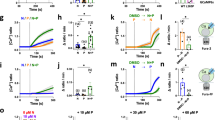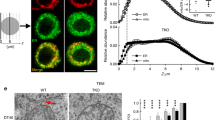Abstract
INOSITOL 1,4,5-trisphosphate (InsP3) is an established mediator of intracellular Ca2+ signals1 but little is known of the nature and organization of Ca2+ regulatory organelles responsive to InsP3. Here we derive new information from the study of Ca2+ movements induced both by InsP3 and a specific GTP-activated Ca2+ translocation process2,3. The latter mechanism is clearly distinct from that activated by InsP3 (ref. 4) and may involve the translocation of Ca2+ between compartments without its release into the cytosol5-7. This idea is supported by the fact that GTP activates Ca2+ movement into the InsP3-releasable pool7,8. In the light of this evidence we postulated that there are two intracellular Ca2+ pools distinguishable by InsP3-sensitivity and oxalate-permeability, and that movement between them is activated by GTP7. We report here direct evidence for the existence and separation of two distinct Ca2+-pumping compartments with properties coinciding with those predicted. Of these, the InsP3-sensitive Ca2+ pool is identified within a purified rough endoplasmic reticulum fraction, an observation consistent with recent InsP3 receptor-localization studies9. Ca2+ translocation between pools may reflect function of a class of small GTP-binding proteins known to mediate interorganelle transfer in eukaryotic cells10.
This is a preview of subscription content, access via your institution
Access options
Subscribe to this journal
Receive 51 print issues and online access
$199.00 per year
only $3.90 per issue
Buy this article
- Purchase on Springer Link
- Instant access to full article PDF
Prices may be subject to local taxes which are calculated during checkout
Similar content being viewed by others
References
Berridge, M. J. A. Rev. Biochem. 56, 159–193 (1987).
Dawson, A. P. FEBS Lett. 185, 147–150 (1985).
Gill, D. L., Ueda, T., Chueh, S. H. & Noel, M. W. Nature 320, 461–464 (1986).
Chueh, S. H. & Gill, D. L. J. biol. Chem. 261, 13883–13886 (1986).
Chueh, S. H., Mullaney, J. M., Ghosh, T. K., Zachary, A. L. & Gill, D. L. J. biol. Chem. 262, 13857–13864 (1987).
Mullaney, J. M., Chueh, S. H., Ghosh, T. K. & Gill, D. L. J. biol. Chem. 262, 13865–13872 (1987).
Mullaney, J. M., Yu, M., Ghosh, T. K. & Gill, D. L. Proc. natn. Acad. Sci. U.S.A. 85, 2499–2503 (1988).
Thomas, A. P. J. biol. Chem. 263, 2704–2711 (1988).
Ross, C. A., Meldolesi, J., Milner, T. A., Satoh, T., Supattapone, S. & Snyder, S. H. Nature 339, 468–470 (1989).
Bourne, H. R. Cell 53, 669–671 (1988).
Ghosh, T. K., Eis, P. S., Mullaney, J. M., Ebert, C. L. & Gill, D. L. J. biol. Chem. 263, 11075–11079 (1988).
Ueda, T., Chueh, S. H., Noel, M. W. & Gill, D. L. J. biol. Chem. 261, 3184–3192 (1986).
Adelman, M. R., Blobel, G & Sabatini, D. D. Meth. Enzym. 31, 201–215 (1974).
Supattapone, S., Worley, P. F., Baraban, J. M. & Snyder, S. H. J. biol. Chem. 263, 1530–1534 (1988).
Martonosi, A. N. In Calcium in Cell Function Vol. 3 (ed. Cheung, W. Y.) 37–102 (Academic, New York, 1982).
Franke, W. W. Int. Rev. Cytol. Suppl. 4, 71–236 (1974).
Kaprielian, Z. & Fambrough, D. M. Devl Biol. 124, 490–503 (1987).
Henkart, M. Fed Proc. 39, 2783–2789 (1980).
Volpe, P. et al. Proc. natn. Acad. Sci. U.S.A. 85, 1091–1095 (1988).
McGrath, J. P., Capon, D. J., Goeddel, D. V. & Levinson, A. D. Nature 310, 644–649 (1984).
Schmitt, H. D., Wagner, P., Pfaff, E. & Gallwitz, D. Cell 47, 401–412 (1986).
Goud, B., Salminen, A., Walworth, N. C. & Novick, P. J. Cell 53, 753–768 (1988).
Schmitt, H. D., Puzicha, M. & Gallwitz, D. Cell 53, 635–647 (1988).
Beckers, C. J. M. & Balch, W. E. J. Cell Biol. 108, 1245–1256 (1989).
Morris, A. P., Gallacher, D. V., Irvine, R. F. & Petersen, O. H. Nature 330, 653–655 (1987).
Hill, T. D., Dean, N. M. & Boynton, A. L. Science 242, 1176–1178 (1988).
Berridge, M. J. & Galione, A. FASEB J. 2, 3074–3082 (1988).
Gill, D. L. & Chueh, S. H. J. biol. Chem. 260, 9289–9297 (1985).
Gill, D. L., Chueh, S. H. & Whitlow, C. L. J. biol. Chem. 259, 10807–10813 (1984).
Author information
Authors and Affiliations
Rights and permissions
About this article
Cite this article
Ghosh, T., Mullaney, J., Tarazi, F. et al. GTP-activated communication between distinct inositol 1,4,5-trisphosphate-sensitive and -insensitive calcium pools. Nature 340, 236–239 (1989). https://doi.org/10.1038/340236a0
Received:
Accepted:
Issue Date:
DOI: https://doi.org/10.1038/340236a0
This article is cited by
-
Cellular and molecular mechanisms regulating vascular tone. Part 1: basic mechanisms controlling cytosolic Ca2+ concentration and the Ca2+-dependent regulation of vascular tone
Journal of Anesthesia (2007)
-
Effects of Guanine Nucleotides and Protein Kinase C on Prolactin-Stimulated Release of Ca2+ from Intracellular Stores of Pig Oocytes
Russian Journal of Developmental Biology (2005)
-
Role of matrix metalloprotease-2 in oxidant activation of Ca2+ATPase by hydrogen peroxide in pulmonary vascular smooth muscle plasma membrane
Journal of Biosciences (2003)
-
Activation of microsomal cytochrome P450 mono‐oxygenase by Ca2+ store depletion and its contribution to Ca2+ entry in porcine aortic endothelial cells
British Journal of Pharmacology (1997)
-
Calcium pools, calcium entry, and cell growth
Bioscience Reports (1996)
Comments
By submitting a comment you agree to abide by our Terms and Community Guidelines. If you find something abusive or that does not comply with our terms or guidelines please flag it as inappropriate.



